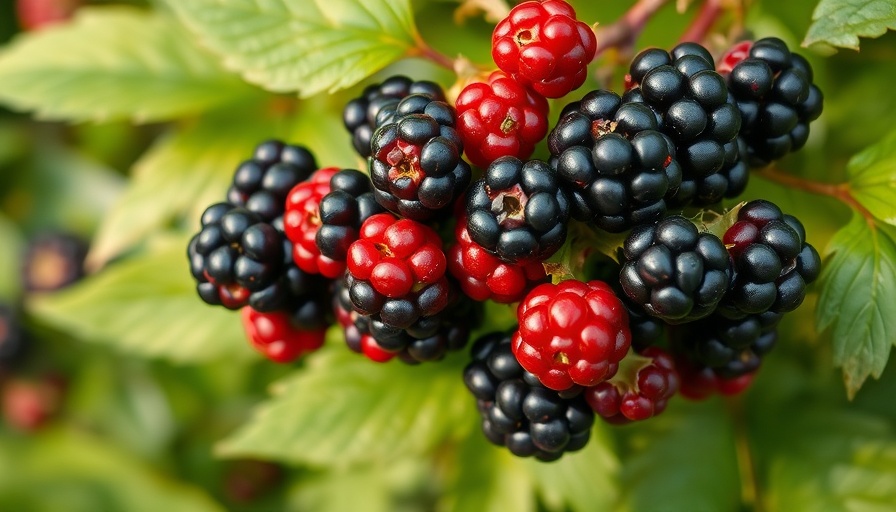
Understanding Berry Canes: A Beginner's Guide
As you stroll through your local nursery, you might encounter tags that read "fall bearing" or "everbearing," leaving you puzzled about what they truly mean for your gardening efforts. If you've recently muzzled through terms like "primocane" and "floricane" without a clue, you're not alone. With so many options available, distinguishing between these varieties can seem overwhelming. However, this guide simplifies the differences and clarifies how these two types of berry canes work.
What Are Canes?
First off, let’s define some terminology. The word canes refers to the shoots of plants in the Rubus genus, commonly referred to as cane berries or brambles. These plants include various fruits such as blackberries, raspberries, and boysenberries. If you encounter these terms, just remember that they refer to the same concept: the shoots that produce fruit differences in their lifecycle.
Primocane vs. Floricane: What’s the Difference?
The key to understanding is in the names. Think of primocane as your plant's first-year shoots. These fresh canes grow vigorously and are primarily focused on vegetative growth. During late summer or fall, you may even see them starting to develop flower buds that will produce fruit in the following year. On the other hand, floricanes represent the same shoots after they've matured—typically by the second season. It's during this period that berries start to ripen and are ready for harvesting.
Instead of confounding yourself with which category a cane belongs to, consider whether it's in its primocane or floricane phase. This way, you’re acknowledging the plant’s growth stage rather than trying to label it unnecessarily.
Recognizing Primocanes and Floricanes
So how do you spot a primocane versus a floricane? Primocanes are typically characterized by their thicker, more succulent stems with longer internodes and a lush green color. As they transition into the second season and become floricanes, they start to develop rougher textures and a hardened appearance. This visual change can serve as a cue for gardeners to identify which shoots will yield fruit, as floricanes are primary bearers of berries.
Fruiting Types: What to Expect
One of the most fascinating aspects of Rubus plants is the different types of fruiting behavior they exhibit. Some species are classified as primocane-fruiting while others are floricane-fruiting. Primocane-fruiting varieties will produce fruit on both the first and second-year canes, allowing you to enjoy a bountiful harvest sooner. On the flip side, floricane-fruiting varieties will only bear fruit in the second year, focusing their energy on growth during the first.
Choosing between these types depends largely on your gardening goals. If you're looking for quicker yields, opt for primocane-fruiting varieties to maximize your gardening efforts.
Key Considerations for Gardeners
Understanding the differences between primocanes and floricanes holds significant value for anyone involved in gardening. Whether you're focused on garden design, vegetable gardening, or flower garden maintenance, identifying these canes can enhance your gardening experience. Additionally, knowing which type to plant will aid in landscape planning and garden maintenance.
1. **Landscaping Ideas**: Incorporate primocane and floricane varieties into your garden design based on your desired yield and aesthetic. Placing thornless varieties can streamline the gardening effort while enhancing visual appeal.
2. **Gardening Projects**: If you’re planning on engaging in DIY gardening projects, select primocane-fruiting varieties for rapid results. This is particularly rewarding for beginner gardeners eager to witness quick results. 3. **Garden Care Tips**: Regular pruning can maintain healthy canes. Knowing which canes bear fruit will help you concentrate your care on maximizing the yield year after year.Conclusion: Embrace the Bounty of Berry Canes
As you navigate through the rich and rewarding world of berry canes, remember that understanding the terminology is just the beginning. By learning the distinctive properties of primocanes and floricanes, you can plan more effectively, enjoy greater yields, and really make the most of your gardening journey.
Your garden has the potential to be a vibrant oasis of flavor and beauty. So as you embark on this journey—keep your eyes peeled for those canes, and before you know it, you’ll be harvesting your very own berries!
 Add Row
Add Row  Add
Add 




Write A Comment